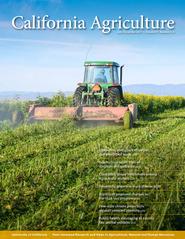All Issues

COVER: Mowing of winter cover crop with a flail mower in a long-term National Research Initiative study of conservation agriculture systems at the UC West Side Research and Extension Center in Five Points, Calif. Cover cropping is an important soil health management practice that has been monitored at the Five Points site. A recent study of sorghum and garbanzo yields in the San Joaquin Valley examined the effects of cover cropping and no-till techniques versus no cover crop and standard tillage (see Mitchell et al., page 112).
Volume 75, Number 3





